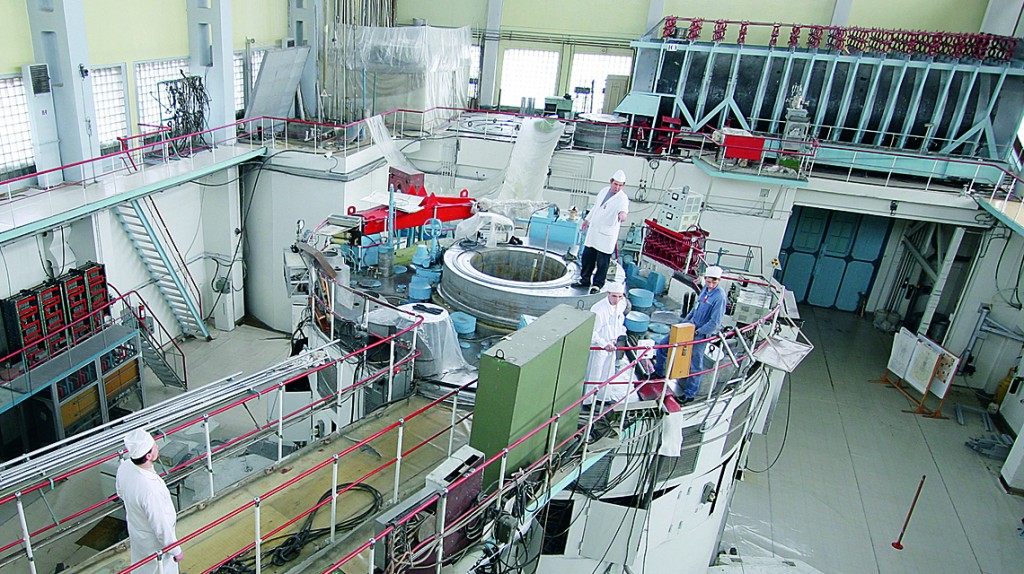The light water research reactor at the Institute of Nuclear Physics (INP) in Alatau, a suburb of Almaty, will reopen in January 2016 following a switch to less proliferation-sensitive low-enriched uranium (LEU), the International Atomic Energy Agency (IAEA) recently reported.
The report, “IAEA Impact: Making the World Safer, One Research Reactor At a Time,” announced that the reactor, which got rid of its highly-enriched uranium (HEU) fuel in an IAEA-sponsored operation last September, will be temporarily turned off to allow for a cooling-off period of six months. This time will be used to replace the reactor’s instrumentation and control system in advance of the fuel switch.
“I am very confident that the reactor will continue its current work after the switch,” Petr Chakrov, the INP’s acting general director, is quoted as saying in the report.
The scientist gladly notes that, “the new core will have twice the capacity to produce various medical [and] other radioisotopes going forward,” referring to the part of the reactor containing the nuclear fuel components where the nuclear reactions actually take place.
In January 2015, the U.S. National Nuclear Security Administration (NNSA) announced the successful completion of operations to fly a total of 36 kilogrammes of HEU on a chartered heavy transport plane from Almaty for permanent disposition at “a secure facility in Russia.” The fuel is to be downblended to a safe substance or securely stored.
The operation marked a notable achievement in a global programme involving the IAEA, Russia and U.S. to assist several countries, including Kazakhstan, in “eliminating the risks associated with HEU, while still maintaining the important scientific research conducted at the reactor.” HEU can be used to power nuclear devices, and there is a fear of the substance falling into the hands of terrorists.
The programme helps change out HEU for LEU. HEU was used in many reactors designed in 1960s and 1970s, when the dangerous fuel was the only option available for performing a range of scientific experiments.
According to the IAEA report, the research purposes of the six-megawatt Alatau reactor include, among others, isotope production for medicine and testing material for use in industry. The reactor produces molybdenum-99, which is “an important medical radioisotope used in 70 percent of nuclear medicine procedures worldwide, and relied on for tens of millions of medical procedures a year.”
Before the implementation of the conversion to LEU began, INP scientists performed studies to determine the suitability of the reactor for conversion to LEU. By analysing specimens irradiated to different doses of radiation, modelling the conditions under which the LEU would be used in the reactor after the conversion, scientists confirmed that the reactor was suitable for using LEU in a safe and manageable way, Chakrov said.
“The procurement of this equipment by the IAEA was absolutely necessary for the project to take place and to give us the confidence to move forward,” the scientist explained.
Furthermore, according to Sandor Tozser, a nuclear engineer at the IAEA’s Research Reactor Section, due to the risks associated with HEU, more than 2,150 kilogrammes of it from the former Soviet Union has been “repatriated” to Russia in 60 shipments from 14 countries under the Tripartite Initiative between Russia, the U.S. and the IAEA. The latter acts as an administrator and provides technical knowledge and equipment. “The repatriation of HEU fuel from the Alatau reactor is part of this programme,” the IAEA said.
An earlier NNSA report quoted U.S. Department of Energy’s NNSA Deputy Administrator Anne Harrington as stating that “the removal of this HEU is yet another example of how the international community continues to work together to prevent the threat of nuclear terrorism.”
“This cooperation reduces the chance that such material can fall into the hands of terrorists,” she said.
Bilateral cooperation between the U.S. and Kazakhstan on these particular issues also includes “improving security for nuclear and radiological materials, constructing a Nuclear Security Training Centre at INP that will serve Kazakhstan’s entire nuclear industry, developing a nuclear security curriculum, providing radiation detection equipment at Kazakhstan’s ports of entry as well as associated training and support for sustainment of equipment, and cooperating on safeguards implementation and training for Kazakhstani officials on export controls,” the NNSA clarified.



